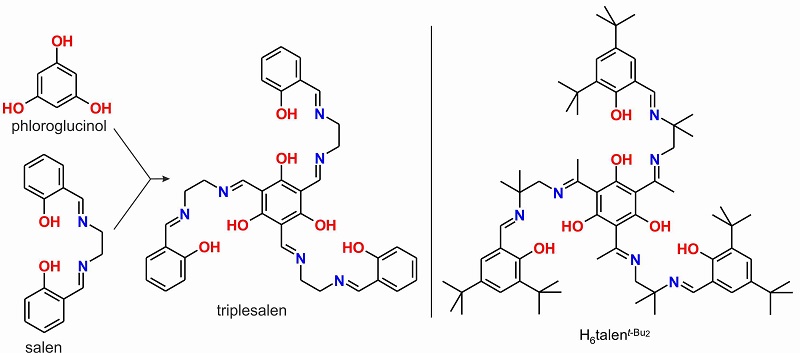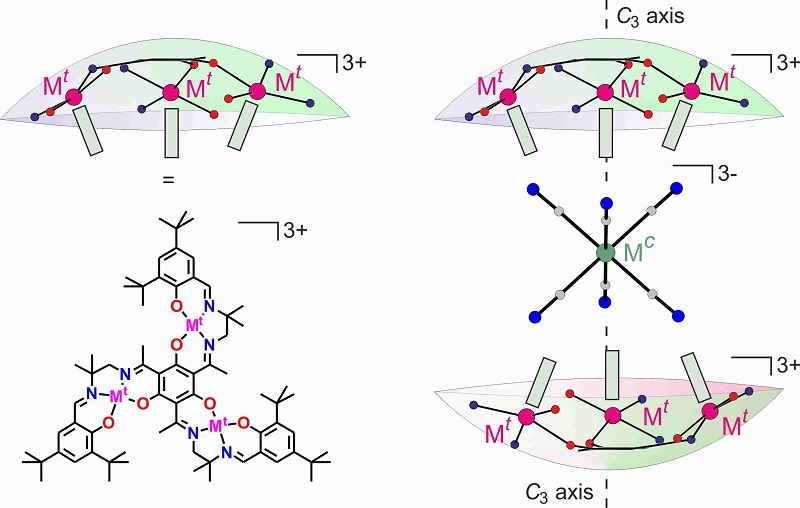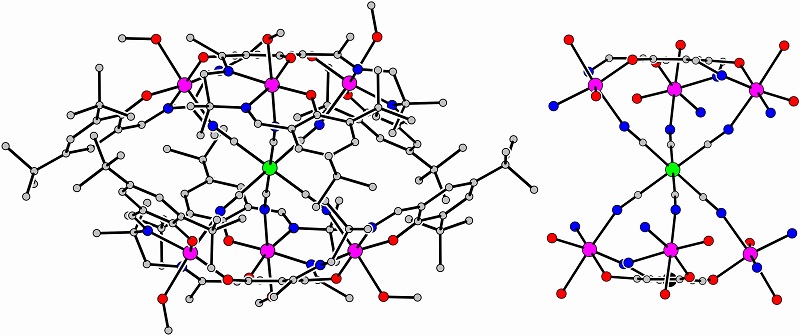A milestone in the field of molecule-based magnetic materials was the observation that [Mn12O12(OAc)16(H2O)4], Mn12, exhibits a hysteresis in the magnetization of pure molecular origin and has been the first member of a new class of molecule-based magnets called single-molecule magnets (SMMs). The origin of SMM behaviour is the existence of an appreciable thermal barrier U for spin-reversal called magnetic anisotropy barrier which is related to the combination of a large total spin ground state (St) and an easy-axis magnetic anisotropy. This energy-barrier U for spin reversal causes a slow relaxation of the magnetization at low temperatures. The magnetic bistability of SMMs promises access to devices for ultimate high-density memory storage and quantum computing. Since the discovery that Mn12 acts as a single-molecule magnet, a still increasing number of SMMs has been identified in the effort to enhance the magnetic anisotropy barrier. However, although great success in increasing the anisotropy barrier U has been reached, the blocking temperature TB, below that the hysteretic behaviour can be observed, did not increase accordingly due to quantum tunneling through the anisotropy barrier. The extensive research on Mn12 and other SMMs has established more prerequisites for a rational development of new SMMs besides the high-spin ground state St and the magnetic anisotropy: the symmetry should be at least C3 to minimize the quantum tunneling of the magnetization through the anisotropy barrier but lower than cubic to avoid the cancellation of the local anisotropies upon projection onto the spin ground state.
Based on these prerequisites, we have designed the new C3 symmetric ligand system triplesalen which combines the phloroglucinol bridging unit for high spin ground states by the spin-polarization mechanism with a salen-like ligand environment for single-site magnetic anisotropies by a strong tetragonal ligand field.

The C3 symmetric, trinuclear complexes of the triplesalen ligand (talent-Bu

In this respect, we have been able to synthesize an isostructural series [Mt6Mc]n+ with varying terminal ions Mt and central ions Mc , which acts as SMMs.

The modular assembly of the heptanuclear complexes from three molecular building blocks allows the fine-tuning of the molecular and steric properties of each building block without losing the driving force for the formation of the heptanuclear complexes. This possibility of rational improvements of our isostructural series is the main advantage of our supramolecular approach to realize SMM behaviour.
Related Publications
J. Oldengott, C.-G. Frhr. Richthofen, S. Walleck, A. Stammler, H. Bögge, and T. Glaser
"Trinuclear Triplesalophen Building Blocks with Terminal Cyanides and Implications for the Spin-Polarization Mechanism for Low-Spin FeIII and CrIII Ions"
Eur. J. Inorg. Chem., 2018, 46, 4987-4996.V. Hoeke, A. Stammler, H. Bögge, and T. Glaser
"Does Symmetry Influence the Properties of [MnIII6CrIII]3+ Single-Molecule Magnets?"
Z. Anorg. Allg. Chem, 2018, 644, 1354-1360.-
J. Oldengott, F. L. B. Röhs, A. Stammler, H. Bögge and T. Glaser
"Increasing the π-π Interactions in Trinuclear NiII3 Triplesalophen Complexes"
Z. Anorg. Allg. Chem., 2017, 643, 819-825. K.-A. Lippert, C. Mukherjee, J.-P. Broschinski, Y. Lippert, S. Walleck, A. Stammler, H. Bögge, J. Schnack, and T. Glaser
"Suppression of Magnetic Quantum Tunneling in a Chiral Single-Molecule Magnet by Ferromagnetic Interactions"
Inorg. Chem, 2017, 56, 15119-15129.J. Donner, J.-P. Broschinski, B. Feldscher, A. Stammler, H. Bögge, T. Glaser and D. Wegner
"Correlating electronic and magnetic coupling in large magnetic molecules via scanning tunneling microscopy"
Phys. Rev. B, 2017, 95, 165441.-
N. Dohmeier, A. Helmstedt, N. Müller, A. Gryzia, A. Brechling, U. Heinzmann, M. Heidemeier, E. Krickemeier, A. Stammler, H. Bögge, T. Glaser, L. Joly and K. Kuepper
"Heptanuclear [FeIII6CrIII]3+ Complexes Experimentally Studied by Means of Magnetometry, x-ray Diffraction, XAS, XMCD and Spin-Polarized Electron Spectroscopy in Cross-Comparison with [MnIII6CrIII]3+ Single-Molecule Magnets"
Magnetochem., 2016, 2, 5. J. Donner, J.-P. Broschinski, T. Glaser, and D. Wegner
"Deposition and Self-Assembly of Large Magnetic Molecules"
J. Phys. Chem. C, 2015, 119, 28660-28665.J. Oldengott, A. Stammler, H. Bögge, and T. Glaser
"Enhancing the Ferromagnetic Coupling in Extended Phloroglucinol Complexes by Increasing the Metal SOMO - Ligand Overlap: Synthesis and Characterization of a Trinuclear CoII3 Triplesalophen
Dalton Trans., 2015, 44, 9732-9735.T. Glaser, V. Hoeke, K. Gieb, J. Schnack, C. Schröder, and P. Müller
"Quantum Tunneling of the Magnetization in [MnIII6M]3+ (M = CrIII, MnIII) SMMs: Impact of Molecular and Crystal Symmetry"
Coord. Chem. Rev., 2015, 289-290, 261-278.A. Helmstedt, N. Dohmeier, N. Müller, A. Gryzia, A. Brechling, U. Heinzmann, V. Hoeke, E. Krickemeyer, T. Glaser, P. Leicht, M. Fonin, T. Tietze, L. Joly, and K. Kuepper
"Probing the magnetic moments of [MnIII6CrIII]3+ single-molecule magnets - A cross comparison of XMCD and spin-resolved electron spectroscopy"
J. Electron. Spectrosc. Relat. Phenom., 2015, 198, 12-19.B. Feldscher, A. Stammler, H. Bögge, and T. Glaser
"Aromatic vs Heteroradialene Character in Extended Phloroglucinol and Thiophloroglucinol Ligands and their Trinuclear Nickel(II) Complexes"
Chem. Asian J., 2014, 9, 2205-2218.A. Gryzia, T. Volkmann, A. Brechling, V. Hoeke, L. Schneider, K. Kuepper, T. Glaser, and U. Heinzmann
"Crystallographic order and decomposition of [MnIII6CrIII]3+ single-molecule magnets deposited in submonolayers and monolayers on HOPG studied by means of molecular resolved atomic force microscopy (AFM) and Kelvin probe force microscopy in UHV"
Nanoscale Res. Lett., 2014, 9, 60.B. Feldscher, H. Theil, A. Stammler, H. Bögge, and T. Glaser
"A Streamlined Synthesis of Extended Thiophloroglucinol Ligands and Their Trinuclear NiII3 Complexes"
Dalton Trans., 2014, 43, 4102-4114.-
C. Mukherjee, V. Hoeke, A. Stammler, H. Bögge, J. Schnack, and T. Glaser
"Switching from Antiferromagnetic to Ferromagnetic Coupling in Heptanuclear [Mt6Mc]n+ Complexes by Going from an Achiral to a Chiral Triplesalen Ligand"
Dalton Trans., 2014, 43, 9690-9703. V. Hoeke, A. Stammler, H. Bögge, J. Schnack, and T. Glaser
"Strong and Anisotropic Superexchange in the Single-Molecule Magnet (SMM) [MnIII6OsIII]3+: Promoting SMM Behavior through 3d-5d Transition Metal Substitution"
Inorg. Chem., 2014, 53, 257-268.E. Krickemeyer, Y. Kaiser, A. Stammler, H. Bögge, and T. Glaser
"Synthesis, Structural, Spectroscopic, Electrochemical, Magnetic, and Catalytic Properties of the Trinuclear MnIII Triplesalen Complex [(talent-Bu2){Mn(OAc)}3] Exhibiting Three Salen-Subunits in a ß-cis-Conformation"
Z. Anorg. Allg. Chem., 2013, 639, (8-9), 1527-1533.V. Hoeke, E. Krickemeyer, M. Heidemeier, H. Theil, A. Stammler, H. Bögge, T. Weyhermüller, J. Schnack, and T. Glaser
"A Comprehensive Study on Triplesalen-Based [MnIII6FeIII]3+ and [MnIII6FeII]2+ Complexes: Redox-Induced Variation of Molecular Magnetic Properties"
Eur. J. Inorg. Chem., 2013, 4398-4409.B. Feldscher, A. Stammler, H. Bögge, and T. Glaser
"From Triplesalen to Triplesalalen to Triplesalan: Strengthening the Aromatic Character of the Ligand Backbone by Prevention of Heteroradialene-Formation"
Eur. J. Inorg. Chem., 2013, 388-397.-
T. Glaser
"Exchange Coupling Mediated by Extended Phloroglucinol Ligands: Spin-Polarization vs Heteroradialene-Formation"
Coord. Chem. Rev. (invited contribution to Honorary Issue on the occasion of the 65th anniversary of Prof. Ed. I. Solomon), 2013, 257, 140-152. C.-G. Frhr. v. Richthofen, B. Feldscher, K.-A. Lippert, A. Stammler, H. Bögge, and T. Glaser
"Electronic and Molecular Structures of Heteroradialenes: A Combined Synthetic, Computational, Spectroscopic, and Structural Study Identifying IR Spectroscopy as a Simple but Powerful Experimental Probe"
Z. Naturforsch., 2013, 68b, 64-86.V. Hoeke, M. Heidemeier, E. Krickemeyer, A. Stammler, H. Bögge, J. Schnack, and T. Glaser
"Structural Influences on the Exchange Coupling and Zero-Field Splitting in the Single-Molecule Magnet [MnIII6MnIII]3+"
Dalton Trans., 2012, 41, 12942-12959.C.-G. Frhr. v. Richthofen, A. Stammler, H. Bögge, and T. Glaser
"Synthesis and Characterization of Trinuclear NiII3 and CuII3 Triplesalophen Complexes: Evaluation of Ligand Folding and Heteroradialene Formation and Their Impact on the Magnetic Properties"
Eur. J. Inorg. Chem., 2012, 5934-5952.V. Hoeke, M. Heidemeier, E. Krickemeyer, A. Stammler, H. Bögge, J. Schnack, A. Postnikov, and T. Glaser
"Environmental Influence on the Single-Molecule Magnet Behavior of [MnIII6CrIII]3+: Molecular Symmetry versus Solid-State Effects"
Inorg. Chem., 2012, 51, 10929-10954.B. Feldscher, H. Theil, A. Stammler, H. Bögge, and T. Glaser
"A Bioinspired Enhancement of Superexchange: From 1,3,5-Trihydroxybenzene-Bridged to 1,3,5-Trimercaptobenzene-Bridged Trinuclear Copper(II) Complexes"
Inorg. Chem., 2012, 51, 8652-8654.A. Helmstedt, M. O. Sacher, A. Gryzia, A. Harder, A. Brechling, N. Müller, U. Heinzmann, V. Hoeke, E. Krickemeyer, T. Glaser, S. Bouvron and M. Fonin
"Exposure of [MnIII6CrIII]3+ Single-Molecule Magnets to Soft X-Rays: The Effect of the Counterions on Radiation Stability"
J. Electron Spectrosc. Relat. Phenom., 2012, 184, 583-588.-
V. Hoeke, K. Gieb, P. Müller, L. Ungur, L. F. Chibotaru, M. Heidemeier, E. Krickemeyer, A. Stammler, H. Bögge, C. Schröder, J. Schnack, and T. Glaser
"Hysteresis in the Ground and Excited Spin State Up to 10 T of a [MnIII6MnIII]3+ Triplesalen Single-Molecule Magnet"
Chem. Science, 2012, 3, 2868-2882. B. Feldscher, E. Krickemeyer, M. Moselage, H. Theil, V. Hoeke, Y. Kaiser, A. Stammler, H. Bögge, and T. Glaser
"An Inverted Triplesalen Ligand by a Convergent Synthesis and its Influence on Trinuclear FeIII3 Complexes"
Sci. China: Chem. (invited contribution to special issue Molecular Magnetism), 2012, 55, 951-966.C. G. Frhr. v. Richthofen, A. Stammler, H. Bögge, T. Glaser
"Probing the Radialene-Character in Triplesalophen Ligands by Spectroscopic and Structural Analysis"
J. Org. Chem., 2012, 77, 1435-1448.B. Feldscher, A. Stammler, H. Bögge, and T. Glaser
"Synthesis and Characterization of Trinuclear Square-Planar NiII3 and CuII3 Complexes of an Extended Phloroglucinol Ligand: Experimental Evidence for the Relative Contributions of Benzene-like and Radialene-like Resonance Structures"
Polyhedron, 2011, 30, 3038-3047.A. Gryzia, H. Predatsch, A. Brechling, V. Hoeke, E. Krickemeyer, T. Glaser, and U. Heinzmann
"Preparation of Monolayers of [MnIII6CrIII]3+-Single-Molecular-Magnets on HOPG-, Mica- and Silicon-Surfaces and characterization by means of nc-AFM"
Nanoscale Res. Lett., 2011, 6, 486.A. Helmstedt, N. Müller, A. Gryzia, N. Dohmeier, A. Brechling, M. D. Sacher, U. Heinzmann, V. Hoeke, E. Krickemeyer, T. Glaser, S. Bouvron, M. Fonin, and M. Neumann
"Spin-resolved Photoelectron Spectroscopy of [MnIII6CrIII]3+ Single-Molecule-Magnets and of Manganese Compounds as Reference Layers"
J. Phys. Condens. Matter, 2011, 23, 266001.C.-G. Frhr. v. Richthofen, A. Stammler, H. Bögge, and T. Glaser
"From Triplesalen to Triplesalophen: Ferromagnetic Interactions via Spin-polarization in a Trinuclear NiII Triplesalophen Complex" "From Triplesalen to Triplesalophen: Ferromagnetic Interactions via Spin-polarization in a Trinuclear NiII Triplesalophen Complex"
Eur. J. Inorg. Chem. 2011, 49-52.T. Glaser
"Rational Design of Single-Molecule Magnets: A Supramolecular Approach"
Invited Feature Article
Chem. Commun. 2011, 47, 116-130.E. Krickemeyer, V. Hoeke, A. Stammler, H. Bögge, J. Schnack, and T. Glaser
"Synthesis and Characterization of the Heptanuclear Triplesalen Complex [MnIII6CoIII]3+: Evidence for Exchange Pathways Involving CoIII l. s."
Z. Naturforsch. (Rolf W. Saalfrank Honorary Issue) 2010, 65b, 295-303.S. Walleck, H. Theil, M. Heidemeier, G. Heinze-Brückner, A. Stammler, H. Bögge, and T. Glaser
"From Triplesalen to Triplesalacen: Synthesis and Properties of the Trinuclear CuII3 Triplesalacen Complex"
Inorg. Chim. Acta (A. Müller Honorary Issue) 2010, 363, 4287-4294.B. Feldscher, A. Stammler, H. Bögge, and T. Glaser
"Synthesis and Characterization of a Trinuclear CuII3 Complex bridged by an Extended Phloroglucinol-Ligand: Implications for a Rational Enhancement of Ferromagnetic Interactio ns"
Dalton Trans. 2010, 39, 11675-11685.T. Glaser, M. Heidemeier, H. Theil, A. Stammler, H. Bögge, and J. Schnack
"A Trinuclear MnIII Triplesalen-Based 1D Pearl Necklace: Exchange Interactions and Zero-Field Splittings in a C3-Symmetric MnIII6 Complex"
Dalton Trans. 2010, 39, 192-199.C.-G. Frhr. von Richthofen, A. Stammler, H. Bögge, M. W. DeGroot, J. R. Long, and T. Glaser
"Synthesis, Structure, and Magnetic Characterization of a C3-Symmetric MnIII3CrIII Assembly: Molecular Recognition Between a Trinuclear MnIII Triplesalen Complex and a fac-Triscyano CrIII Complex"
Inorg. Chem. 2009, 48, 10165-10176.H. Theil, R. Fröhlich, and T. Glaser
"A Triple Newman-Kwart Rearrangement at a Fully Substituted Benzene Ring"
Z. Naturforsch. (Hubert Schmidbaur Honorary Issue) 2009, 64b, 1633-1638.T. Glaser, M. Heidemeier E. Krickemeyer, H. Bögge, A. Stammler, R. Fröhlich, E. Bill, J. Schnack
"Exchange Interactions and Zero-Field Splittings in C3-Symmetric MnIII6FeIII: Using Molecular Recognition for the Construction of a Series of High Spin Complexes Based on the Triplesalen Ligand"
Inorg. Chem. 2009, 48, 607-620.T. Glaser, H. Theil, and M. Heidemeier
"Spin-polarization in 1,3,5-Trihydroxybenzene-Bridged First-Row Transition Metal Complexes"
C. R. Chimie (invited contribution to thematic issue "New Trends in Molecular Magnetism") 2008, 11, 1121-1136.H. Theil, C.-G. Freiherr von Richthofen, E. Krickemeyer, A. Stammler, H. Bögge, and T. Glaser
"Ferromagnetic Coupling by the Spin-Polarization Mechanism in a Trinuclear VIV Triplesalen Complex"
Inorg. Chim. Acta (Edward I. Solomon Honorary Issue) 2008, 361, 916-924.T. Glaser, M. Heidemeier, J. B. H. Strautmann, H. Bögge, A. Stammler, E. Krickemeyer, R. Huenerbein, S. Grimme, E. Bothe, and E. Bill
"Trinuclear Copper Complexes with Triplesalen Ligands: Geometric and Electronic Effects on the Ferromagnetic Coupling via the Spin-Polarization Mechanism"
Chem. Eur. J. 2007, 13, 9191-9206.T. Glaser, M. Heidemeier, and R. Fröhlich
"The First Trinuclear Manganese Triplesalen Complex: Synthesis, Structural, and Magnetic Characterization of [(talenNO2){MnIII(DMSO)2}3](ClO4)3"
C. R. Chimie 2007, 10, 71-78.T. Glaser, M. Heidemeier, T. Weyhermüller, R.-D. Hoffmann, H. Rupp, and P. Müller
"Property-Oriented Rational Design of Single-Molecule Magnets: A C3-Symmetric Mn6Cr Complex Based on Three Molecular Building Blocks with a Spin Ground State of St = 21/2"
Angew. Chem. Int. Ed. 2006, 45, 6033-6037.T. Glaser, M. Heidemeier, R. Fröhlich, P. Hildebrandt, E. Bothe, and E. Bill
"Trinuclear Nickel Complexes with Triplesalen Ligands: Simultaneous Occurrence of Mixed Valence and Valence Tautomerism in the Oxidized Species"
Inorg. Chem. 2005, 44, 5467-5482.T. Glaser, M. Heidemeier, S. Grimme, and E. Bill
"Targeted Ferromagnetic Coupling in a Trinuclear Copper(II) Complex: Analysis of the St = 3/2 Spin Ground State"
Inorg. Chem. 2004, 43, 5192-5194.T. Glaser, T. Lügger, and R. Fröhlich
"Synthesis, Crystal Structures, and Magnetic Properties of a Mononuclear and a Dinuclear Copper(II) Complex of the Ligand 2,4,6-Tris-(2-pyridyl)-1,3,5-triazine"
Eur. J. Inorg. Chem. 2004, 394-400.T. Glaser, M. Heidemeier, and T. Lügger
"The Novel Triplesalen Ligand Bridges Three NiII-Salen Subunits in a meta-Phenylene Linkage"
Dalton Trans. 2003, 2381-2383.T. Glaser, M. Gerenkamp, and R. Fröhlich
"Gezielte Synthese von ferromagnetisch gekoppelten Komplexen mit modifizierten 1,3,5-Trihydroxybenzolliganden"
Angew. Chem. 2002, 114, 3984-3986.